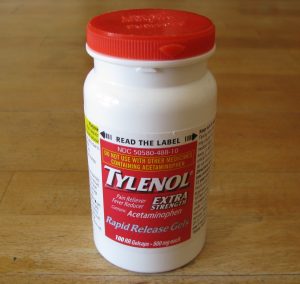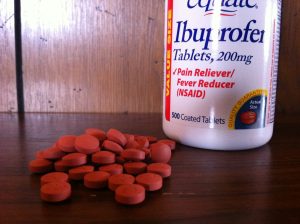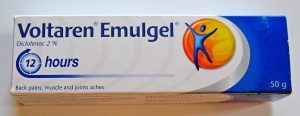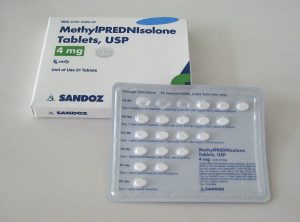4.4 Musculoskeletal System Medications
Some of the more common musculoskeletal system medications are discussed below. Focus is placed on the pathologies already mentioned in this chapter, and many of the pathologies are treated with the same medications. It is also important to note that many musculoskeletal pathologies are treated with multiple medications in addition to other types of therapies.
Medications for Osteoarthritis (OA)
Osteoarthritis (OA) is typically treated with a variety of non-opioid analgesics. The goal is to reduce pain and improve the ability to move more comfortably (Mayo Clinic, 2023f). In addition, treatment may include lifestyle changes, such as weight loss and low-impact exercise, and for severe cases, arthroplasty may be required (Betts et al., 2013). Some of the common medications used to treat OA are described below. Many, as previously mentioned, are used to treat other musculoskeletal pathologies and will be described later on this page (Betts et al., 2013).
Acetaminophen
Acetaminophen (Tylenol) (Fig. 4.14) is a non-opioid analgesic that can be used for mild to moderate pain. It also has an antipyretic therapeutic effect. It does not cause stomach irritation and is well tolerated if taken as prescribed. Acetaminophen should not be used to treat inflammation because it has no anti-inflammatory properties. The preferred route is oral, and the medication comes in the form of liquid, tablets, and capsules but can also be taken rectally in the form of a suppository. Acetaminophen can be used to treat pain associated with OA but not inflammation (Arthritis Society Canada, 2023a).

Salicylate Medications
Salicylate medications can be taken to help alleviate pain and can be administered in a variety of routes, including orally and topically. These medications can be used when pain is not relieved by acetaminophen or for those wanting an alternative medication route; typically, for OA, the preferred medication route is topical.
The following are some common topical creams used for OA (Arthritis Society of Canada, 2023h):
- antiphlogistine (Rub A535)
- menthol topical (BenGay)
- trolamine salicylate (Aspercreme)
Acetylsalicylic acid (Aspirin) is a common salicylate medication that relieves pain and reduces inflammation and fever by inhibiting the production of prostaglandins. It also decreases platelet aggregation. For OA, it would primarily be used for its anti-inflammatory and analgesic effects. The preferred route for acetylsalicylic acid is orally, but it can be taken rectally and intravenously as well. It can cause stomach irritation and is available as an enteric-coated tablet that should not be crushed, chewed, or broken; it should be swallowed whole. The chewable tablet form must be chewed before swallowing.
Key Concept
A common abbreviation for acetylsalicylic acid is ASA.
Acetylsalicylic acid (Aspirin) has the following four therapeutic effects:
- anticoagulant
- analgesic
- antipyretic
- anti-inflammatory
Nonsteroidal Anti-Inflammatory Drugs (NSAIDs)
Nonsteroidal anti-inflammatory drugs (NSAIDs) have analgesic, antipyretic, and anti-inflammatory effects. If there is inflammation involved in the pathology, then the NSAIDs listed below could be used in the course of treatment. Fig. 4.15 is an image of the common NSAID ibuprofen, which is often the first line of treatment for OA (Arthritis Society Canada, 2023f). NSAIDs help with both the pain and inflammation associated with OA, but they do not change the course of the disease (Arthritis Society Canada, 2023f). NSAIDs are often used in combination with disease-modifying antirheumatic drugs (DMARDs) or biologics (Arthritis Society Canada, 2023e). Diclofenac (Voltaren) is a commonly used topical treatment for the pain of OA and is often preferred over oral NSAID medications (Fig. 4.16).
The following is a list of common NSAIDs used for OA that have been recommended by the Arthritis Society of Canada (2023f):
- diclofenac (Voltaren)
- flurbiprofen (Ansaid)
- ibuprofen (Advil, Motrin)
- indomethacin (Indocid)
- ketorolac (Toradol)
- naproxen (Aleve)


Key concept
A common suffix in generic nonsteroidal anti-inflammatory (NSAID) medication names is -profen.
Examples: ibuprofen (Advil), flurbiprofen (Ansaid)
COX-2 Inhibitor Medications
Celecoxib (Celebrex) is a COX-2 inhibitor and is currently the only COX-2 inhibitor available on the market in Canada. It specifically inhibits the enzyme COX-2 that is required for the synthesis of prostaglandins. Celecoxib is used to treat the pain associated with osteoarthritis, as well as rheumatoid arthritis (including juvenile), and ankylosing spondylitis.
Key Concept
The common suffix with COX-2 inhibitor medications is -coxib.
Example: Celecoxib (Celebrex)
Corticosteroid Medications
Corticosteroid medications are similar to the hormones produced by the human body and reduce pain and inflammation. Corticosteroids can be used to treat various conditions, including respiratory ailments such as COPD and asthma, dermatologic pathologies, and many others, including various musculoskeletal pathologies such as osteoarthritis, rheumatoid arthritis, bursitis, and tendinitis.
Prednisone is perhaps the most widely used of the systemic corticosteroids. It is generally used as an anti-inflammatory and immunosuppressive agent; however, prednisone is not recommended for osteoarthritis (Arthritis Society of Canada, 2023g). Corticosteroids should never be stopped abruptly, and if a patient has been using them for more than 10 days, the dose must be slowly tapered. This means starting with a larger dose and slowing decreasing it. Fig. 4.17 shows an example of a tapered dose of medication.
Corticosteroids can be taken by various routes, including orally, topically, intravenously, and by subcutaneous or intramuscular injection. Most commonly with osteoarthritis, corticosteroids are injected directly into the joint or around the tendon, and the lasting effects vary from days to months (Arthritis Society Canada, 2023i).

The following is a list of common corticosteroids medications that are used to treat various types of arthritis, including osteoarthritis (Arthritis Society Canada, 2023g):
- betamethasone (Celestone Soluspan)
- methylprednisolone (Depo-medrol)
- prednisone (Winpred)
- triamcinolone (Kenalog, Aristospan)
Key concept
Common suffixes in generic corticosteroid medication names are -lone and -sone.
Examples: methylprednisolone (Depo-medrol), prednisone (Winpred), betamethasone (Celestone)
Medications for Gout
There are a couple of primary medications used in the treatment of gout. Colchicine (Colchicine-Odan) is used to help treat and prevent gout attacks. It has two therapeutic effects: anti-inflammatory and analgesic. This medication is taken orally in pill form and works best if taken within 24 hours of a gout attack (Arthritis Society Canada, 2023d).
Allopurinol (Zyloprim) is another frequently used medication in the treatment of gout. It is used to decrease the levels of uric acid in the blood and helps prevent the reoccurrence of a gout attack. Allopurinol blocks the production of uric acid by the body’s cells, and by doing so, lowers the risk of an attack (Arthritis Society Canada, 2023b). It is administered orally in tablet form, and the dose may require adjustment based on a patient’s renal function (Arthritis Society Canada, 2023b). It can take several weeks for allopurinol to take effect, so it may be used in combination with an NSAID or colchicine (Arthritis Society Canada, 2023b).
Medications for Rheumatoid Arthritis (RA)
The treatment of all arthritis pathologies can be complicated; each patient’s experience can vary, so their treatment plan may vary as well (Betts et al., 2013). This section will focus on some of the common medications used to treat rheumatoid arthritis, but it is certainly not a complete list—there is always new research and new medications being developed. RA can be treated with non-prescription medications such as acetaminophen and NSAIDs as described above, but these are usually prescribed in combination with medications from other categories. One of these medication categories is called disease modifying anti-rheumatic drugs (DMARDs). The goal of DMARDs is to reduce inflammation and prevent joint damage. Medications in this category can be administered orally, subcutaneously, or intramuscularly, depending on the medication (Arthritis Society Canada, 2023e). The corticosteroid prednisone might be prescribed as well and is taken orally.
Biologics or biosimilars are medications produced from living cells and work by suppressing the immune system with the goal of reducing pain, improving the symptoms related to RA, and slowing the disease progression (Arthritis Society Canada, 2023g). Biologics can be given subcutaneously or intravenously (Arthritis, Society Canada, 2023c).
The following list includes only a few examples of medications in each of the categories described above (Arthritis Society Canada, 2023c):
Disease-modifying anti-rheumatic drugs (DMARDs):
- hydroxychloroquine (Plaquenil)
- methotrexate (Metoject)
Corticosteroids:
- prednisone (Winpred)
Biologics:
- abatacept (Orencia)
- adalimumab (Humira)
- etanercept (Enbrel)
The video below gives an overview of the medications used to treat arthritis. You can find a complete list of medications in the Arthritis Society Canada Medication Reference Guide.
(Arthritis Society Canada, 2018)
Medications for Bursitis
Treatments for bursitis can include antibiotics if the bursitis is caused by an infection or anti-inflammatory agents, such as nonsteroidal anti-inflammatory drugs (NSAIDs) or corticosteroids, which can be injected into the bursa if the bursitis is caused by trauma or overuse. Injections usually work quickly and typically only one injection is needed for the patient to have relief (Mayo Clinic, 2023a). Chronic bursitis may require that fluid be drained, but additional surgery is usually not required. In addition to medications, patients may be encouraged to rest, apply ice, and see a physical therapist (Mayo Clinic, 2023a).
Medications for Tendinitis
The treatment for tendinitis may be a combination of therapies, including rest, ice, and physical therapy, and if the symptoms do not diminish, then surgical repair might be considered. The pain associated with tendinitis can be treated with acetaminophen, NSAIDs, and acetylsalicylic acid, which are most commonly administered either orally or topically (Mayo Clinic, 2023d). At times, a steroid injection into the tendon might be considered for the pain, but it is not recommended that this treatment be repeated because it can increase the likelihood of the tendon weakening and tearing (Mayo Clinic, 2023d).
Medications for Osteoporosis (OP)
Current treatments for managing osteoporosis (OP) typically include one of the medications discussed below. Various medications are available, and treatment plans vary depending on an individual’s results and experiences with side effects. Patients are encouraged to investigate different options and choose the one that works best for them.
Bisphosphonates
Current treatments for managing osteoporosis include bisphosphonates—the most common class of drugs prescribed for osteoporosis (Betts et al., 2013). These medications work by binding to the bones and slowing the action of the osteoclasts, allowing the osteoblasts to be more productive.
The following is a list of common bisphosphonate medications used to treat osteoporosis, the administration route, and how often these medications are taken (Osteoporosis Canada, 2023a).
- alendronate (Fosamax) – a daily or weekly pill
- risedronate (Actonel) – a daily or weekly pill
- etidronate (Didrocal) – taken daily for two weeks followed by a blue calcium tablet daily for an additional 10 weeks
- zoledronic acid (Aclasta) – intravenously once a year
Key Concept
A common suffix in generic bisphosphonate medication names is -dronate.
Examples: alendronate (Fosamax), risedronate (Actonel), etidronate (Didrocal)
Human Monoclonal Antibodies
Denosumab (Prolia) is in a class of medications called human monoclonal antibodies (Osteoporosis Canada, 2023b). It is a fairly new medication used to treat osteoporosis and works by stopping the activation of osteoclasts. It is administered by injection twice a year and has been shown to decrease the risk of fractures in both men and women (Osteoporosis Canada, 2023b).
Hormone Therapy (HT)
Hormone therapy (HT) is another treatment option for osteoporosis, more specifically estrogen/progesterone as these hormones play a role in maintaining bone density (Osteoporosis Canada, 2023c). Menopause leads to a decrease in these hormones, which in turn can result in bone thinning and loss. Ideally, the treatment should use the lowest dose possible that is needed to prevent this from happening because hormone treatment has been shown to increase the risk of some cancers, stroke, blood clots, and cardiovascular disease (Osteoporosis Canada, 2023c). Because of these risks, other treatment options should be considered for the prolonged treatment of postmenopausal osteoporosis. Treatment could involve a combination of both progesterone and estrogen or just estrogen alone. Both hormones are typically taken orally in the form of a tablet (Osteoporosis Canada, 2023c).
Selective Estrogen Receptor Modulators (SERMs)
Raloxifene (Evista) is a common medication that acts like estrogen but belongs to a class of medications known as selective estrogen receptor modulators (SERMs) (Web MD, 2023a). It improves bone density in postmenopausal women without the dangerous side effects associated with estrogen, but it unfortunately can still increase the risk of blood clots (Mayo Clinic, 2023c). Raloxifene is taken once a day orally, preferably around the same time every day (Osteoporosis Canada, 2023c).
Medications for Paget’s Disease
Bisphosphonates, as mentioned above, are medications that decrease the activity of osteoclasts and are often used to treat Paget’s disease. However, in a small percentage of cases, bisphosphonates have been linked to an increased risk of fractures because the old bone that is left after the medication is administered becomes worn out and brittle (Betts et al., 2013). Still, in many cases, the benefits more than outweigh the risks. Bisphosphonate treatment can reduce the overall risk of deformities or fractures, which in turn reduces the need for surgical repair and its associated risks and complications (Betts et al., 2013).
Table 4.1. Common Musculoskeletal System Medications
| Generic Name | Trade Name | Reason for Administering |
| antiphlogistine | Rub A535 | OA |
| betamethasone | Celestone Soluspan | OA |
| diclofenac | Voltaren | OA |
| flurbiprofen | Ansaid | OA |
| indomethacin | Indocid | OA |
| menthol topical | BenGay | OA |
| methylprednisolone | Depo-Medrol | OA |
| triamcinolone | Kenalog, Aristospan | OA |
| trolamine salicylate | Aspercreme | OA |
| ibuprofen | Advil, Motrin | OA, gout |
| ketorolac | Toradol | OA, gout |
| naproxen | Aleve | OA, gout |
| celecoxib | Celebrex | OA, RA |
| acetaminophen | Tylenol | OA, RA, tendinitis |
| acetylsalicylic acid | Aspirin | OA, tendinitis |
| allopurinol | Zyloprim | Gout |
| colchicine | Colchicine-Odan | Gout |
| abatacept | Orencia | RA |
| adalimumab | Humira | RA |
| etanercept | Enbrel | RA |
| hydroxychloroquine | Plaquenil | RA |
| methotrexate | Metoject | RA |
| prednisone | Winpred | RA |
| alendronate | Fosamax | OP |
| denosumab | Prolia | OP |
| estrogen/progesterone | – | OP |
| etidronate | Didrocal | OP |
| raloxifene | Evista | OP |
| risedronate | Actonel | OP |
Attribution
Unless otherwise indicated, material on this page has been adapted from the following resource:
Ernstmeyer, K., & Christman, E. (Eds.). (2020). Nursing pharmacology. Chippewa Valley Technical College. https://wtcs.pressbooks.pub/pharmacology/, licensed under CC BY 4.0
References
Arthritis Society Canada. (2023a). Acetaminophen. https://arthritis.ca/treatment/medication/medication-reference-guide/medications/acetaminophen
Arthritis Society Canada. (2023b). Allopurinol. https://arthritis.ca/treatment/medication/medication-reference-guide/medications/allopurinol
Arthritis Society Canada. (2023c). Biologics and biosimilars for the treatment of inflammatory arthritis. https://arthritis.ca/treatment/medication/biologics-and-biosimilars
Arthritis Society Canada. (2023d). Colchicine. https://arthritis.ca/treatment/medication/medication-reference-guide/medications/colchicine
Arthritis Society Canada. (2023e). Disease-modifying anti-rheumatic drugs (DMARDs). https://arthritis.ca/treatment/medication/disease-modifying-anti-rheumatic-drugs-(dmards)
Arthritis Society Canada. (2023f). Non-steroidal anti-inflammatory drugs (NSAIDs). https://arthritis.ca/treatment/medication/medication-reference-guide/medications/non-steroidal-anti-inflammatory-drugs-(nsaids)
Arthritis Society Canada. (2023g). Prednisone. https://arthritis.ca/treatment/medication/medication-reference-guide/medications/prednisone
Arthritis Society Canada. (2023h). Salicylate. https://arthritis.ca/treatment/medication/medication-reference-guide/medications/salicylate
Arthritis Society Canada. (2023i). Steroid injection. https://arthritis.ca/treatment/medication/medication-reference-guide/medications/steroid-injection
Arthritis Society Canada. (2018, March 23). Inflammatory arthritis medications simplified [Video]. YouTube. https://www.youtube.com/watch?v=gqGo9qiHDZU
Betts, J. G., Young, K. A., Wise, J. A., Johnson, E., Poe, B., Kruse, D. H., Korol, O., Johnson, J. E., Womble, M., & DeSaix, P. (2013). Anatomy and physiology. OpenStax. https://openstax.org/details/books/anatomy-and-physiology, licensed under CC BY 4.0
Mayo Clinic. (2023a). Bursitis. https://www.mayoclinic.org/diseases-conditions/bursitis/diagnosis-treatment/drc-20353247
Mayo Clinic. (2023b). Osteoarthritis. https://www.mayoclinic.org/diseases-conditions/osteoarthritis/diagnosis-treatment/drc-20351930
Mayo Clinic. (2023c). Osteoporosis treatment: Medications can help. https://www.mayoclinic.org/diseases-conditions/osteoporosis/in-depth/osteoporosis-treatment/art-20046869
Mayo Clinic. (2023d). Tendinitis. https://www.mayoclinic.org/diseases-conditions/tendinitis/diagnosis-treatment/drc-20378248
Osteoporosis Canada. (2023a). Bisphosphonates. https://osteoporosis.ca/bisphosphonates/
Osteoporosis Canada. (2023b). Denosumab. https://osteoporosis.ca/denosumab/
Osteoporosis Canada. (2023c). Hormone therapy (HT). https://osteoporosis.ca/hormone-therapy/
Osteoporosis Canada. (2023d). SERMs: Selective estrogen receptor modulators. https://osteoporosis.ca/serms/
WebMD. (2023a). Evista strengthens bone, safe on uterus. https://www.webmd.com/osteoporosis/news/20030718/evista-strengthens-bones-safe-on-uterus
WebMD. (2023b). Drugs & medications A–Z. https://www.webmd.com/drugs/2/index
Image Credits (images are listed in order of appearance)
Tylenol bottle closeup (loose crop) by Colin, CC BY-SA 2.0
Equate Ibuprofen Pills and Bottle by ParentingPatch, CC BY-SA 3.0
Вольтарен Эмульгель by Schekinov Alexey Victorovich, CC BY-SA 4.0
Sandoz.Methylprednisolone.4mg by Anonymous, Public domain
joint replacement surgery
medication used to reduce fevers
a group of lipids that are made at sites of tissue damage or infection
blood clotting
slowly lowering the dose of a medication
cells that eat away bone
bone-building cells

